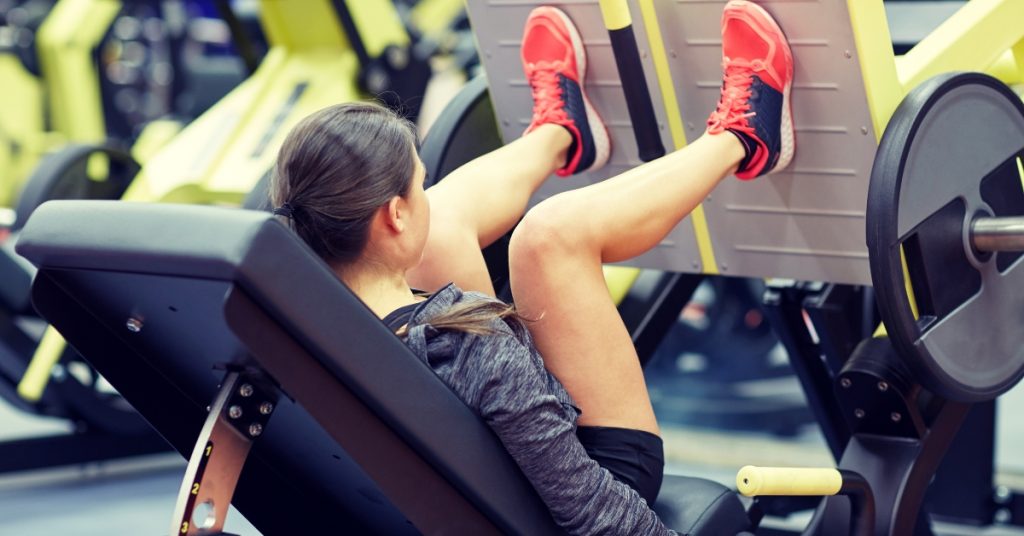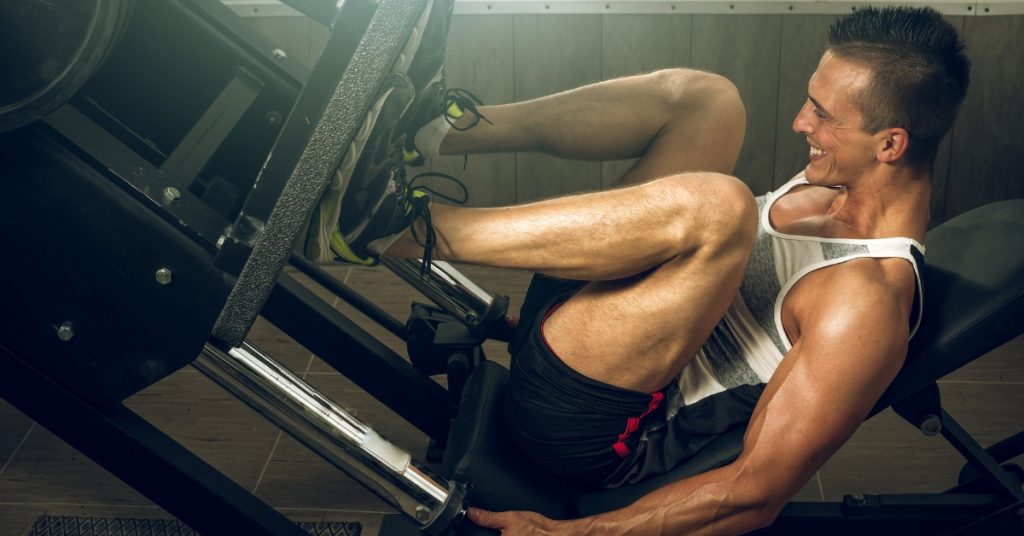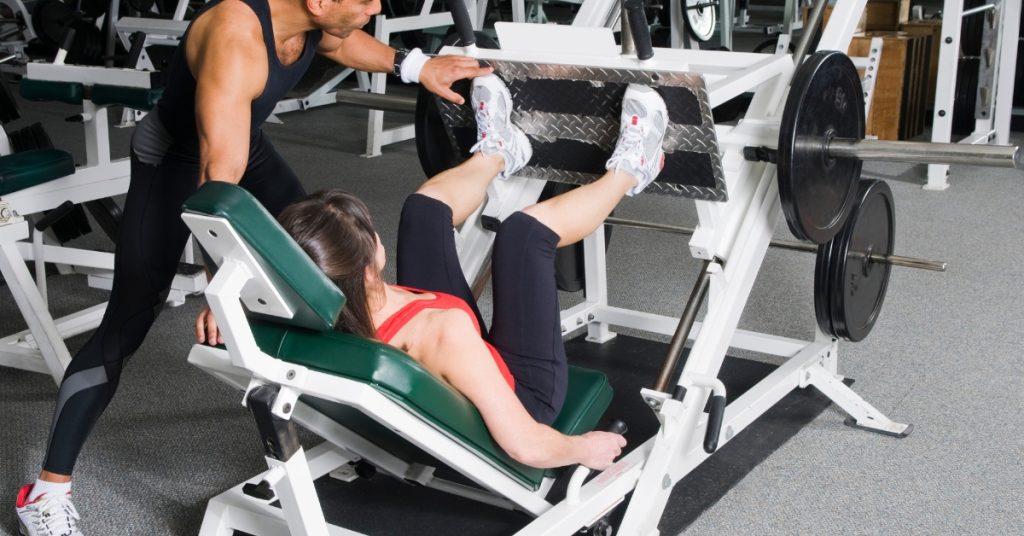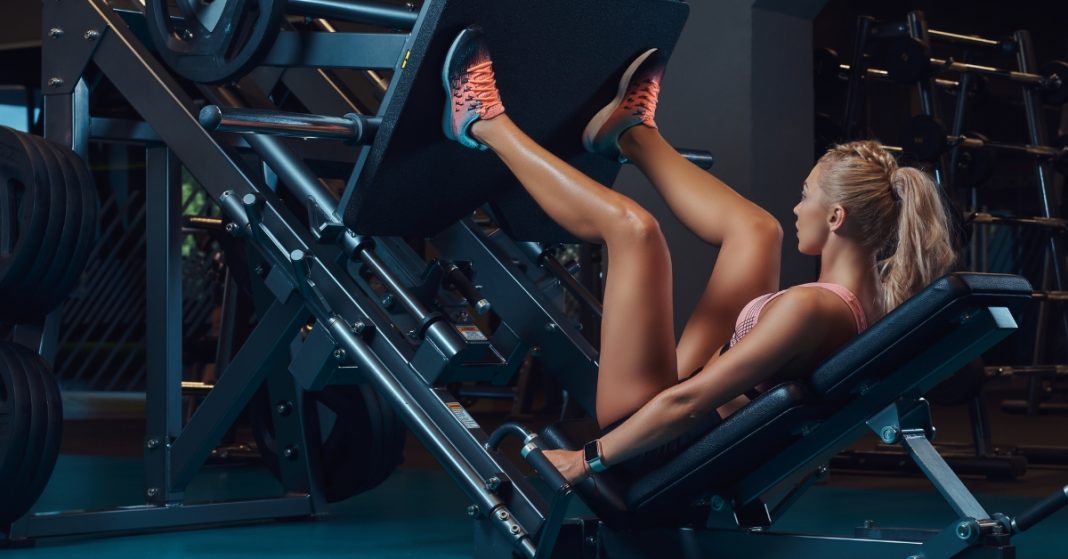You’ve probably walked into the gym, looked at the leg press machine, and thought, “Where should I place my feet today?” It’s a valid question! Foot placement isn’t just about comfort; it’s a strategic decision that can make all the difference in your workout results. By adjusting your feet just a few inches up or down, or left or right, you can emphasize different muscle groups.
Table of Contents
Ever wondered why your quads burn with one placement and your glutes feel the tension with another? It’s all in the details. In this post, we’ll delve into the art and science of leg press foot placement, breaking down positions for the quads, glutes, and hamstrings. So, the next time you’re strapped into that leg press machine, you’ll know exactly where your feet should go for your desired results. Let’s dive in!
Leg Press Foot Placement: The Key to Effective Training

Ah, the leg press. It’s more than just a chunk of metal waiting for you at the gym; it’s a tool that, when used correctly, can sculpt your lower body like no other. But how do you know you’re using it right? It begins with where you place your feet.
Importance of Proper Leg Press Positions
The Science Behind Foot Placement
Before we dive into specifics, let’s get a grasp on the basics. Foot placement on the leg press isn’t arbitrary. It’s rooted in biomechanics – how our bodies move and the forces acting upon them. Here’s a breakdown:
- Angle of Push: Depending on where your feet are, the angle at which you push can activate different muscle fibers.
- Muscle Length: As you change your foot position, you alter the length and tension of specific muscles. This can influence which muscles take on more of the work during the press.
- Joint Stress: Your foot position can either alleviate or put more stress on joints like your knees and hips. For instance, a higher foot placement might reduce stress on the knees but emphasize the hips more.
Impact on Muscle Engagement
Your foot placement is a silent communicator to your muscles. Here’s a systematic look at how it speaks:
- Quads: Placing your feet lower on the platform and closer together primarily targets the quadriceps.
- Glutes: If you’re after a toned posterior, placing your feet higher and wider can shift more work to the glutes.
- Hamstrings: An intermediate foot position, not too high or too low, will pull in the hamstrings for assistance.
Remember, it’s not just about muscle development but also about ensuring joint health. Being strategic with your leg press foot placement ensures that you’re not just working out effectively, but safely too.
In the next sections, we’ll go deeper into how we can tweak our placements for specific results. Whether you’re looking to build powerful quads or lift that booty, the leg press has got you covered. All it takes is a little knowledge and experimentation. So, grab your gym shoes, and let’s get pressing!
Foot Placement on Leg Press: Basics to Know

Navigating the leg press for the first time can be a tad overwhelming. All those handles, settings, and that massive platform staring back at you, challenging you to make a move. But fear not! With a handful of basic pointers, you’ll go from novice to pro in no time.
Ideal Leg Press Placement for Beginners
Starting with the Basics
Let’s simplify things a bit. When you’re starting out, you don’t need to overthink every inch of your foot placement. Here’s a straightforward approach to get you going:
- Position Feet Shoulder-Width Apart: This is a natural stance that mimics how you’d stand on the ground. It ensures an even distribution of weight and force.
- Center Your Feet on the Platform: Align your feet so they’re directly in line with your shoulders. This can prevent any unnecessary sideways forces that might strain your knees.
- Keep Feet Flat: This might seem obvious, but ensuring your entire foot remains in contact with the platform helps in evenly distributing pressure.
Adjusting for Comfort and Safety
Every person’s body is unique. While the basics provide a great starting point, you’ll want to make small adjustments based on how your body feels. Here’s a checklist to guide your tweaks:
- Knee Alignment: Ensure that your knees are pointing in the same direction as your feet. If there’s any discomfort, try slightly adjusting your foot angle.
- Hip Comfort: If you feel excessive strain in your hips, consider shifting your feet a bit higher or lower until you find a comfortable spot.
- Foot Angle: Some people prefer a slight outward turn of the feet, while others keep them straight. See what feels best for your body.
- Listen to Your Body: Always the golden rule! If something feels off, it probably is. Make minor adjustments until you find your comfort zone.
Embarking on your leg press journey doesn’t have to be complicated. Once you nail the basics, you’ll be confidently adjusting and experimenting in no time. In the following sections, we’ll explore more advanced techniques, but for now, focus on mastering these foundational steps. Your legs will thank you!
Different Leg Press Positions for Targeted Results

The leg press is like an artist’s palette and your feet? Well, they’re the brush. By simply shifting your foot placement, you can paint different parts of your legs with muscle tone and strength. Whether you’re sculpting quads, boosting the booty, or honing those hamstrings, here’s the inside scoop on getting targeted results.
Quad Focused Leg Press
Ah, the quadriceps. These powerful muscles at the front of your thigh aren’t just for show. They’re instrumental in functions like walking, running, and jumping. Let’s learn how to give them the spotlight.
Positioning Tips for Quad Dominance:
- Lower Foot Placement: By placing your feet lower on the platform, you’ll notice a more intense engagement in the quads during the press.
- Feet Closer Together: A narrower stance further isolates the quads, especially the outer ones.
- Full Range of Motion: Ensure you go deep enough so that your knees are close to your chest without lifting your glutes off the seat.
Benefits of Quad Targeting:
- Stronger Knees: Quads play a crucial role in stabilizing the knee. Strengthening them can lead to better joint health.
- Enhanced Mobility: Powerful quads can help with tasks like climbing stairs or squatting.
Leg Press Positioning for Glutes
Dreaming of a stronger, perkier posterior? The leg press can be your secret weapon. Here’s how to dial up the glute engagement.
How to Hit the Glutes Effectively:
- Higher Foot Placement: Elevate your feet towards the top of the platform. This angle activates the glutes more during the push phase.
- Wider Stance: A stance wider than shoulder-width places greater emphasis on the glutes and outer thighs.
- Deep Press: Lower the weight slowly and press deep to ensure maximum gluteal engagement.
Enhancing Gluteal Muscle Activation:
- Mind-Muscle Connection: Focus on the squeeze at the top of the press. It’s not just about moving the weight but consciously engaging the glutes throughout.
- Vary Your Foot Turn: A slight outward turn of the feet can sometimes enhance glute activation.
How to Hit Hamstrings on Leg Press
The hamstrings, those muscles at the back of your thighs, often play second fiddle to quads and glutes. But a well-rounded leg workout gives them their due.
Hamstring-centric Positioning:
- Mid-Level Foot Placement: Not too high, not too low. This central placement brings the hamstrings into the mix more prominently.
- Feet Shoulder-Width Apart: A standard stance ensures balanced engagement between quads and hamstrings.
Results to Expect with Hamstring Focus:
- Balanced Leg Development: Focusing on hamstrings ensures your legs aren’t front-heavy, leading to a more harmonious leg shape.
- Improved Stability: Strong hamstrings offer better balance and can aid in preventing injuries, especially during dynamic movements.
Foot placement is like a secret code to unlocking various muscle groups. By understanding and experimenting with these positions, you can tailor your workouts to target specific areas of your lower body. Happy pressing!
Seated Leg Press Foot Placement Variations

The seated leg press is a favorite among gym-goers, and for good reason. Its reclined position allows for a controlled motion and focused muscle engagement. But like any other machine, its benefits are truly unlocked when we fine-tune the details. In this case, it’s all about foot placement.
Adjusting Stance for Comfort and Effectiveness
The right foot placement doesn’t just maximize your muscle targeting; it ensures that you’re working out in a manner that’s kind to your joints and comfortable for your body. Here’s how to strike that balance:
Narrow vs. Wide Stance:
Narrow Stance:
- Muscle Focus: Primarily targets the outer quads.
- Joint Consideration: Ensure your knees don’t buckle inward. Keep them in line with your toes.
- Best For: Individuals looking to emphasize the teardrop muscle (vastus medialis) of the quads.
Wide Stance:
- Muscle Focus: Engages the inner thighs and glutes more.
- Joint Consideration: Watch out for excessive outward knee movement.
- Best For: Those aiming for comprehensive inner leg and gluteal engagement.
High vs. Low Placement:
High Placement:
- Muscle Focus: Puts more emphasis on the hamstrings and glutes.
- Joint Consideration: This can be more comfortable for those with knee concerns as it reduces direct stress on the knee joint.
- Best For: Anyone focusing on posterior leg development.
Low Placement:
- Muscle Focus: Targets the quadriceps dominantly.
- Joint Consideration: Monitor the knees. They should not travel too far beyond the toes during the press.
- Best For: Quad development enthusiasts.
The seated leg press, with its myriad foot placement options, offers a rich playground for leg workouts. By understanding the subtle nuances of stance and positioning, you can not only amplify your results but make your workouts more enjoyable and comfortable. Up next, we’ll dive deeper into advanced techniques for the leg press enthusiasts ready to up their game! Stay tuned!
Leg Press Stance and Its Role in Muscle Engagement

The leg press is a treasure trove of potential for those who wish to sculpt their lower body. But beyond foot position, the angle or stance of your feet can also influence which muscles are called into action. It’s like turning a dial: with every tweak, you tune into a different muscle frequency.
Experimenting with Different Angles
Angles might remind you of geometry class, but in the gym, they’re the key to refined muscle targeting. Let’s dive into the art of angling those feet:
Inward and Outward Foot Angles:
- Inward Foot Angle (Pigeon Toed):
- Muscle Focus: Targets the outer quads and outer hamstrings.
- Execution: Turn your toes slightly inward, ensuring that knees follow the direction of the toes during the press to prevent strain.
- Best For: Those looking to emphasize the lateral aspect of their thighs.
- Outward Foot Angle (Duck Footed):
- Muscle Focus: Engages the inner quads and adductors (inner thigh muscles) more profoundly.
- Execution: Angle your toes outward, but ensure your knees track in the same direction to avoid undue stress.
- Best For: Individuals aiming to work on their inner thigh gap or strengthen their adductors.
Impact on Muscle Recruitment:
- Fine-Tuning Activation: Adjusting your foot angle can help you hone in on specific muscle fibers that might not be engaged with a standard stance.
- Balanced Development: Periodically altering your foot angle ensures that you aren’t neglecting any part of your leg muscles, leading to a well-rounded and balanced leg development.
- Reduced Plateaus: Changing angles and experimenting helps in presenting new challenges to the muscles, which can be instrumental in breaking through workout plateaus.
Angles and stances in the leg press are akin to flavor profiles in cooking. Just as a dash of spice can change a dish’s entire taste, a slight change in foot angle can dramatically shift your muscle engagement. The next time you’re at the leg press machine, consider it a culinary experiment for your muscles. Bon appétit, or shall we say, happy pressing!
Leg Press Focus on Quads: Maximizing Quadriceps Activation

Ah, the quadriceps! This group of muscles at the front of our thighs is not just one of the most impressive to look at but also integral to so many movements we perform daily. From powerfully kicking a ball to simply standing up from a chair, the quads are always at play. If you’ve ever wanted to give them extra attention on the leg press, you’re in the right place.
Tips and Techniques for Quad Engagement
Maximizing quad activation doesn’t require a magic formula, but it does need some attention to detail. Let’s break it down:
Depth and Angle Considerations:
- Shallow Depth: Contrary to what many think, you don’t always have to go super deep to activate the quads. Sometimes, a shallower press with a focus on the upward push can emphasize quad engagement.
- Lower Foot Placement: Keeping your feet lower on the platform will invariably target the quads more. This position increases the knee angle, making the quads work harder.
- Straight Foot Angle: Instead of turning your feet inward or outward, keep them straight. This neutral position ensures even quad muscle activation.
Common Mistakes to Avoid:
- Overextending the Knees: When pressing, avoid locking out your knees completely. This not only places undue stress on the joint but also reduces muscle tension, making the exercise less effective.
- Lifting the Heels: Ensure your entire foot, especially the heel, remains flat on the platform. Lifting the heel can diminish quad activation and put more strain on the knees.
- Rushing the Movement: Slow and controlled is the game. A hasty push and release can reduce the time under tension for the quads, making the exercise less effective.
Focusing on the quads doesn’t mean neglecting other muscles. It’s about giving a prime muscle group its due attention. With these tips, the next time you’re on the leg press, you can confidently dial up the quad engagement and feel the burn in all the right places. Keep pressing and keep growing those mighty quads!
Advanced Leg Press Techniques for Enhanced Muscle Focus

For those who have been pressing for a while, the leg press machine might start to feel a bit routine. But here’s a secret: it doesn’t have to be. Even a seasoned gym-goer can find new challenges and muscle-focus techniques with this versatile equipment. Ready to elevate your leg press game?
Tweaking Placement for Personalized Results
The beauty of the leg press lies in its adaptability. It can be as individual as you are, tailored to fit your specific goals and needs. Let’s explore how you can personalize your pressing experience.
Listening to Your Body:
- Feedback Loop: The most reliable guide on foot placement and depth is your own body. If a particular stance causes discomfort or feels off, it’s essential to adjust accordingly. Your body will often signal what’s working and what’s not.
- Muscle Mind Connection: This isn’t just gym jargon. By genuinely focusing on the muscles you’re trying to work, you can often enhance their activation. It’s about mentally zoning in on the muscle and feeling every contraction and relaxation.
- Periodic Change: Our bodies adapt, and what worked a few months ago might not be as effective now. By routinely altering your foot placement, depth, and stance, you can keep your muscles guessing and growing.
Adjusting for Injury Prevention and Recovery:
- Lower Weights, Higher Reps: If you’re coming back from an injury or want to prevent one, consider lowering the weight and increasing the reps. This method still offers muscle engagement but reduces the strain on joints and tendons.
- Avoiding Deep Presses: For those with knee issues, extremely deep presses can sometimes exacerbate discomfort. Consider a moderate-depth press to keep the knees happy.
- Customized Foot Position: If you’ve had an injury, your ideal foot position might differ from textbook recommendations. Maybe a slightly wider stance alleviates hip strain, or a higher placement is gentler on the knees. The key is to find what works best for your unique situation.
Advanced leg press techniques aren’t just about pushing heavier weights; they’re about understanding and connecting with your body at a deeper level. By fine-tuning your approach, listening to feedback, and being mindful of injury prevention, you can unlock a whole new world of leg press possibilities. Keep pressing, keep exploring, and most importantly, keep enjoying the journey of muscle growth and strength!
To Wrap It Up!
The leg press is more than just another piece of gym equipment; it’s a canvas where we paint our strength, growth, and resilience. Through varying foot placements, angles, and stances, we can target, challenge, and sculpt our muscles in countless ways. But remember, the most effective technique is the one tailored to your body, goals, and comfort. So, as you venture into your next leg press session, armed with this knowledge, take a moment to connect, listen, and adjust. After all, every press is a step closer to your fitness aspirations. Happy pressing!
FAQs
What is the best foot position for a leg press?
The best foot position varies by individual goals. Typically, a shoulder-width stance with feet set in the middle of the platform targets overall leg muscles evenly.
How should I position myself for leg press?
Sit comfortably with your back flat against the padded support, place your feet shoulder-width apart on the platform, and ensure your knees are aligned with your toes.
What is the standard leg press position?
The standard position involves feet shoulder-width apart, centered on the platform, with toes pointing slightly outward. This ensures balanced muscle engagement.
What stance should I use for leg press?
Use a shoulder-width stance with toes slightly outwards for general muscle engagement. Adjusting stance width and foot angle can target specific leg muscles more intensely.

